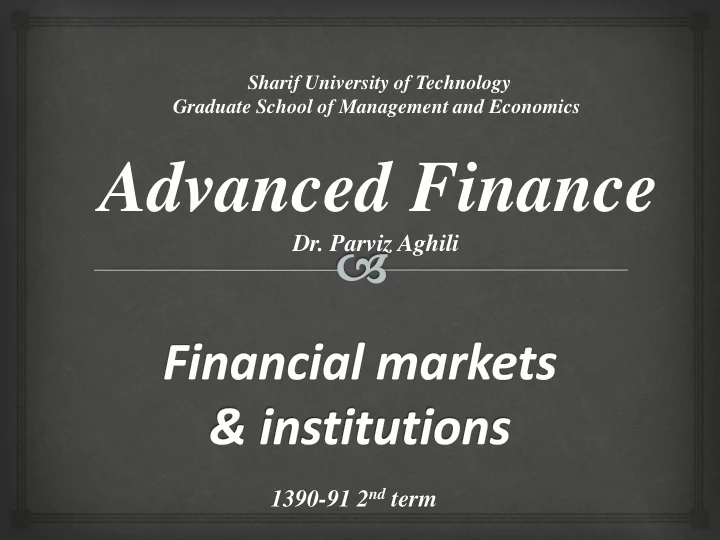

Sharif University of Technology Graduate School of Management and Economics Advanced Finance Dr. Parviz Aghili 1390-91 2 nd term
Introduction The financial system is the mechanism through which loanable funds reach borrowers. Through the operation of the financial markets, money is exchanged for financial claims in the form of stocks, bonds, and other securities, effectively transforming savings into investment so that production, employment, and income can grow.
The Creation of Financial Assets A financial asset is … a claim against the income or wealth of a business firm, household, or unit of government, represented usually by a certificate, receipt, computer record file, or other legal document, and usually created by or related to the lending of money.
Characteristics of Financial Assets Financial assets are sought after because they promise future returns to their owners and serve as a store of value (purchasing power). They do not depreciate like physical goods, and their physical condition or form is usually not relevant in determining their market value. Their cost of transportation and storage is low, such that they have little or no value as a commodity. Financial assets are fungible – they can easily be changed in form and substituted for other assets.
Different Kinds of Financial Assets Any financial asset that is generally accepted in payment for the purchases of goods and services is a form of money . Examples include currency and checking accounts. Equities represent ownership shares in a business firm and are claims against the firm’s profits and proceeds from the sale of its assets. Common stock and preferred stock are equities.
Different Kinds of Financial Assets Debt securities entitle their holders to a priority claim over the holders of equities to the assets and income of an economic unit. They are either negotiable or nonnegotiable. Examples include bonds, notes, accounts payable, and savings deposits. Derivatives have a market value that is tied to or influenced by the value or return on a financial asset. Examples include futures contracts, options, and swaps.
What is Money? M 3 M 2 Household large time M 1 holdings of deposits, savings The most Institutional deposits, liquid forms money-market small time of money, funds, repurchase + deposits, and namely agreements, and + non- currency and other larger liquid institutional checkable assets. money market deposits. funds.
The Evolution of Financial Transactions Financial systems change constantly in response to shifting demands from the public, the development of new technology, and changes in laws and regulations. Over time, the ways of carrying out financial transactions have evolved in complexity. In particular, the transfer of funds from savers to borrowers can be accomplished in at least three different ways.
The Evolution of Financial Transactions Direct Finance – Direct lending gives rise to direct claims against borrowers. Flow of funds (loans of spending power for an agreed-upon period of time) Ultimate supplier Ultimate user of of funds funds (DBUs) (SBUs) Primary Securities (stocks, bonds, notes, etc., evidencing direct claims against borrowers) Simple Difficult to match & risky
The Evolution of Financial Transactions Semidirect Finance – Direct lending with the aid of market makers who assist in the sale of direct claims against borrowers. Primary Securities Primary Securities (direct claims (direct claims Security against against borrowers) brokers, borrowers) Ultimate users Ultimate suppliers dealers, & of funds of funds (SBUs) (DBUs) investment Proceeds of Flow of funds bankers security sales (loans of (less fees and commissions) spending power) Lower search (information) costs Risky & matching is still required
The Evolution of Financial Transactions Indirect Finance – Financial intermediation of funds. Secondary Securities Primary Securities (indirect claims against ultimate (direct claims against ultimate borrowers issued by financial borrowers in the form of loan intermediaries in the form of contracts, stocks, bonds, deposits, insurance policies, notes, etc.) retirement savings accounts, etc.) Financial intermediaries Ultimate Ultimate (banks, savings and loan associations, suppliers of users of insurance companies, credit unions, funds funds mutual funds, finance companies, (SBUs) (DBUs) pension funds) Flow of funds Flow of funds (loans of spending power) (loans of spending power) Low risk & affordable
Bank-Dominated Vs. Security-Dominated Financial Systems Lesser-developed financial systems are often bank- dominated financial systems , in which banks and other similar institutions dominate in supplying credit and attracting savings. The more mature systems today are becoming security- dominated financial systems , in which traditional intermediaries play lesser roles and growing numbers of borrowers sell securities to the public to raise the funds they need.
Financial Markets where financial instruments are bought and sold these markets provide liquidity for buying/selling information through prices risk-sharing among buyers/sellers classified in various ways…
Primary vs. Secondary Markets primary market newly issued securities -- investment banking secondary market brokers match buyers and sellers dealers act as buyers and sellers -- “market - makers”
Debt vs. Equity Markets debt security cash flows are fixed bonds, loans equity security cash flow variable, residual common stock
Exchanges vs. OTC Markets exchange buying & selling of securities in physical location NYSE OTC (over-the-counter) dealers in many locations buy & sell securities
Money vs. Capital Markets money market short-term debt securities (up to 1 yr.) highly liquid, low risk capital market longer-term debt equity
U.S. Tbills Money Market 3% CDs 4% 9% 20% 0% Commercial Paper Banker's Acceptances Repos Federal 39% 25% Funds Eurodollars
Capital Market Stock 4% 8% 11% Mortgages U.S. bonds Municipal 59% bonds 18% Loans
Classification of Financial Institutions Depository institutions derive the bulk of their loanable funds from deposit accounts sold to the public. Commercial banks savings and loan associations savings banks credit unions.
Classification of Financial Institutions Contractual institutions attract funds by offering legal contracts to protect the saver against risk. Insurance companies pension funds.
Classification of Financial Institutions Investment institutions sell shares to the public and invest the proceeds in stocks, bonds, and other assets. Investment companies money market funds real estate investment trusts.
Recommend
More recommend